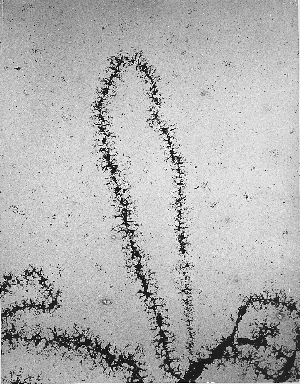6. The extended state of lampbrush chromosomes
18.6 The extended state of lampbrush chromosomes |
| Key terms defined in this section |
| Chromomeres are densely staining granules visible in chromosomes under certain conditions, especially early in meiosis, when a chromosome may appear to consist of a series of chromomeres. Lampbrush chromosomes are the large meiotic chromosomes found in amphibian oocytes. |
It would be extremely useful to visualize gene expression in its natural state, to see what structural changes are associated with transcription. The compression of DNA in chromatin, coupled with the difficulty of identifying particular genes within it, makes it impossible to visualize the transcription of individual active genes.
Gene expression can be visualized directly in certain unusual situations, in which the chromosomes are found in a highly extended form that allows individual loci (or groups of loci) to be distinguished. Lateral differentiation of structure is evident in many chromosomes when they first appear for meiosis. At this stage, the chromosomes resemble a series of beads on a string. The beads are densely staining granules, properly known as chromomeres. However, usually there is little gene expression at meiosis, and it is not practical to use this material to identify the activities of individual genes. But an exceptional situation that allows the material to be examined is presented by lampbrush chromosomes, which have been best characterized in certain amphibians.
Lampbrush chromosomes are formed during an unusually extended meiosis, which can last up to several months! During this period, the chromosomes are held in a stretched-out form in which they can be visualized in the light microscope. Later during meiosis, the chromosomes revert to their usual compact size. So the extended state essentially proffers an unfolded version of the normal condition of the chromosome.
 |
Figure 18.13 A lampbrush chromosome is a meiotic bivalent in which the two pairs of sister chromatids are held together at chiasmata (indicated by arrows). Photograph kindly provided by Joe Gall. |
The lampbrush chromosomes are meiotic bivalents, each consisting of two pairs of sister chromatids. Figure 18.13 shows an example in which the sister chromatid pairs have mostly separated so that they are held together only by chiasmata. Each sister chromatid pair forms a series of ellipsoidal chromomeres, ~1 V2 µm in diameter, which are connected by a very fine thread. This thread contains the two sister duplexes of DNA, and runs continuously along the chromosome, through the chromomeres.
The lengths of the individual lampbrush chromosomes in the newt Notophthalmus viridescens range from 400 V800 µm, compared with the range of 15 V20 µm seen later in meiosis. So the lampbrush chromosomes are ~30 times less tightly packed. The total length of the entire lampbrush chromosome set is 5 V6 mm, organized into ~5000 chromomeres.
The lampbrush chromosomes take their name from the lateral loops that extrude from the chromomeres at certain positions. (These resemble a lampbrush, an extinct object.) The loops extend in pairs, one from each sister chromatid. The loops are continuous with the axial thread, which suggests that they represent chromosomal material extruded from its more compact organization in the chromomere.
 |
Figure 18.14 A lampbrush chromosome loop is surrounded by a matrix of ribonucleoprotein. Photograph kindly provided by Oscar Miller. |
The loops are surrounded by a matrix of ribonucleoproteins. These contain nascent RNA chains. Often a transcription unit can be defined by the increase in the length of the RNP moving around the loop. An example is shown in Figure 18.14.
So the loop is an extruded segment of DNA that is being actively transcribed. In some cases, loops corresponding to particular genes have been identified. Then the structure of the transcribed gene, and the nature of the product, can be scrutinized in situ.